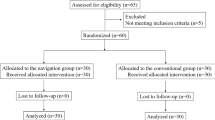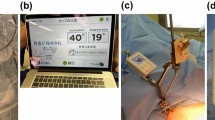Abstract
Background
The use of portable navigation systems (PNS) in total hip arthroplasty (THA) has become increasingly prevalent, with second-generation PNS (sPNS) demonstrating superior accuracy in the lateral decubitus position compared to first-generation PNS. However, few studies have compared different types of sPNS. This study retrospectively compares the accuracy and clinical outcomes of two different types of sPNS instruments in patients undergoing THA.
Methods
A total of 158 eligible patients who underwent THA at a single institution between 2019 and 2022 were enrolled in the study, including 89 who used an accelerometer-based PNS with handheld infrared stereo cameras in the Naviswiss group (group N) and 69 who used an augmented reality (AR)-based PNS in the AR-Hip group (group A). Accuracy error, navigation error, clinical outcomes, and preparation time were compared between the two groups.
Results
Accuracy errors for Inclination were comparable between group N (3.5° ± 3.0°) and group A (3.5° ± 3.1°) (p = 0.92). Accuracy errors for anteversion were comparable between group N (4.1° ± 3.1°) and group A (4.5° ± 4.0°) (p = 0.57). The navigation errors for inclination (group N: 2.9° ± 2.7°, group A: 3.0° ± 3.2°) and anteversion (group N: 4.3° ± 3.5°, group A: 4.3° ± 4.1°) were comparable between the groups (p = 0.86 and 0.94, respectively). The preparation time was shorter in group A than in group N (p = 0.036). There were no significant differences in operative time (p = 0.255), intraoperative blood loss (p = 0.387), or complications (p = 0.248) between the two groups.
Conclusion
An Accelerometer-based PNS using handheld infrared stereo cameras and AR-based PNS provide similar accuracy during THA in the lateral decubitus position, with a mean error of 3°–4° for both inclination and anteversion, though the AR-based PNS required a shorter preparation time.







Similar content being viewed by others
Data availability
The datasets during and/or analyzed during the current study available from the corresponding author on reasonable request.
Abbreviations
- ASIS:
-
Anterior superior iliac spines
- FPP:
-
Functional pelvic plane
- IMU:
-
Inertial measurement unit
- PNS:
-
Portable navigation system
- fPNS:
-
First-generation portable navigation system
- RA:
-
Radiographic anteversion
- RI:
-
Radiographic inclination
- sPNS:
-
Second-generation portable navigation system
- THA:
-
Total hip arthroplasty
- ANCOVA:
-
Analysis of covariance
References
Patil S, Bergula A, Chen PC, Colwell CW Jr, D’Lima DD (2003) Polyethylene wear and acetabular component orientation. J Bone Joint Surg Am 85-A Suppl 4:56–63. https://doi.org/10.2106/00004623-200300004-00007
Nishii T, Sugano N, Miki H, Koyama T, Takao M, Yoshikawa H (2004) Influence of component positions on dislocation: computed tomographic evaluations in a consecutive series of total hip arthroplasty. J Arthroplasty 19(2):162–166. https://doi.org/10.1016/j.arth.2003.09.005
Biedermann R, Tonin A, Krismer M, Rachbauer F, Eibl G, Stöckl B (2005) Reducing the risk of dislocation after total hip arthroplasty: the effect of orientation of the acetabular component. J Bone Joint Surg Br 87(6):762–769. https://doi.org/10.1302/0301-620X.87B6.14745
Maeda Y, Sugano N, Nakamura N, Hamawaki M (2015) The accuracy of a mechanical cup alignment guide in total hip arthroplasty (THA) through direct anterior and posterior approaches measured with CT-based navigation. J Arthroplasty 30(9):1561–1564. https://doi.org/10.1016/j.arth.2015.04.011
Sugano N (2013) Computer-assisted orthopaedic surgery and robotic surgery in total hip arthroplasty. Clin Orthop Surg 5(1):1–9. https://doi.org/10.4055/cios.2013.5.1.1
Kamenaga T, Hayashi S, Hashimoto S, Matsumoto T, Takayama K, Fujishiro T, Hiranaka T, Niikura T, Kuroda R (2019) Accuracy of cup orientation and learning curve of the accelerometer-based portable navigation system for total hip arthroplasty in the supine position. J Orthop Surg (Hong Kong) 27(2):2309499019848871. https://doi.org/10.1177/2309499019848871
Hayashi S, Hashimoto S, Takayama K, Matsumoto T, Kamenaga T, Fujishiro T, Hiranaka T, Niikura T, Kuroda R (2020) Evaluation of the accuracy of acetabular cup orientation using the accelerometer-based portable navigation system. J Orthop Sci 25(4):612–617. https://doi.org/10.1016/j.jos.2019.09.012
Tetsunaga T, Yamada K, Tetsunaga T, Sanki T, Kawamura Y, Ozaki T (2020) An accelerometer-based navigation system provides acetabular cup orientation accuracy comparable to that of computed tomography-based navigation during total hip arthroplasty in the supine position. J Orthop Surg Res 15(1):147. https://doi.org/10.1186/s13018-020-01673-y
Hasegawa M, Naito Y, Tone S, Wakabayashi H, Sudo A (2021) Accuracy of acetabular cup insertion in an anterolateral supine approach using an accelerometer-based portable navigation system. J Artif Organs 24(1):82–89. https://doi.org/10.1007/s10047-020-01206-8
Okamoto M, Kawasaki M, Okura T, Ochiai S, Yokoi H (2021) Comparison of accuracy of cup position using portable navigation versus alignment guide in total hip arthroplasty in supine position. Hip Int 31(4):492–499. https://doi.org/10.1177/1120700020908788
Anjiki K, Kamenaga T, Hayashi S, Hashimoto S, Kuroda Y, Nakano N, Fujishiro T, Hiranaka T, Niikura T, Kuroda R, Matsumoto T (2022) Effectiveness of an accelerometer-based portable navigation for intraoperative adjustment of leg length discrepancy in total hip arthroplasty in the supine position. J Orthop Sci 27(1):169–175. https://doi.org/10.1016/j.jos.2020.11.003
Tanino H, Nishida Y, Mitsutake R, Ito H (2020) Portable accelerometer-based navigation system for cup placement of total hip arthroplasty: a prospective, randomized, Controlled Study. J Arthroplasty 35(1):172–177. https://doi.org/10.1016/j.arth.2019.08.044
Asai H, Takegami Y, Seki T, Ishiguro N (2021) Pelvic tilt reduces the accuracy of acetabular component placement when using a portable navigation system: an in vitro study. Arthroplast Today 1(7):177–181. https://doi.org/10.1016/j.artd.2020.12.012
Tanino H, Nishida Y, Mitsutake R, Ito H (2021) Accuracy of a portable accelerometer-based navigation system for cup placement and intraoperative leg length measurement in total hip arthroplasty: a cross-sectional study. BMC Musculoskelet Disord 22(1):299. https://doi.org/10.1186/s12891-021-04167-y
Tsukamoto M, Kawasaki M, Suzuki H, Fujitani T, Sakai A (2021) Proposal of accurate cup placement procedure during total hip arthroplasty based on pelvic tilt discrepancies in the lateral position. Sci Rep 11(1):13870. https://doi.org/10.1038/s41598-021-93418-y
Kiyohara M, Hamai S, Shiomoto K, Harada S, Harada T, Motomura G, Ikemura S, Fujii M, Kawahara S, Nakashima Y (2022) Does accelerometer-based portable navigation provide more accurate and precise cup orientation without prosthetic impingement than conventional total hip arthroplasty? A randomized controlled study. Int J Comput Assist Radiol Surg 17(6):1007–1015. https://doi.org/10.1007/s11548-022-02592-5
Kurosaka K, Ogawa H, Hirasawa N, Saito M, Nakayama T, Tsukada S (2023) Does augmented reality-based portable navigation improve the accuracy of cup placement in THA compared with accelerometer-based portable navigation? A randomized controlled trial. Clin Orthop Relat Res 481(8):1515–1523. https://doi.org/10.1097/CORR.0000000000002602
Tsukada S, Ogawa H, Hirasawa N, Nishino M, Aoyama H, Kurosaka K (2022) Augmented reality- vs accelerometer-based portable navigation system to improve the accuracy of acetabular cup placement during total hip arthroplasty in the lateral decubitus position. J Arthroplasty 37(3):488–494. https://doi.org/10.1016/j.arth.2021.11.004
Tanino H, Mitsutake R, Takagi K, Ito H (2023) Does a commercially available augmented reality-based portable hip navigation system improve cup positioning during THA compared with the conventional technique? A randomized controlled study. Clin Orthop Relat Res. https://doi.org/10.1097/CORR.0000000000002819
Murray DW (1993) The definition and measurement of acetabular orientation. J Bone Joint Surg Br 75(2):228–232. https://doi.org/10.1302/0301-620X.75B2.8444942
Ektas N, Scholes C, Ruiz AM, Ireland J (2020) Validity of intraoperative imageless navigation (Naviswiss) for component positioning accuracy in primary total hip arthroplasty: protocol for a prospective observational cohort study in a single-surgeon practice. BMJ Open 10(10):e037126. https://doi.org/10.1136/bmjopen-2020-037126
Hasegawa M, Naito Y, Tone S, Sudo A (2022) Accuracy of a novel accelerometer-based navigation (Naviswiss) for total hip arthroplasty in the supine position. BMC Musculoskelet Disord 23(1):537. https://doi.org/10.1186/s12891-022-05495-3
Ohyama Y, Sugama R, Kim Y, Ohta Y, Minoda Y, Nakamura H (2023) A new accelerometer-based portable navigation system provides high accuracy of acetabular cup placement in total hip arthroplasty in both the lateral decubitus and supine positions. Arch Orthop Trauma Surg 143(7):4473–4480. https://doi.org/10.1007/s00402-022-04675-z
Ong CB, Chiu YF, Premkumar A, Gonzalez Della Valle A (2023) Use of a novel imageless navigation system reduced fluoroscopy exposure and improved acetabular positioning in anterior approach total hip arthroplasty: a case-control study. Arch Orthop Trauma Surg 143(5):2739–2745. https://doi.org/10.1007/s00402-022-04520-3
Ogawa H, Hasegawa S, Tsukada S, Matsubara M (2018) A pilot study of augmented reality technology applied to the acetabular cup placement during total hip arthroplasty. J Arthroplasty 33(6):1833–1837. https://doi.org/10.1016/j.arth.2018.01.067
Ogawa H, Kurosaka K, Sato A, Hirasawa N, Matsubara M, Tsukada S (2020) Does an augmented reality-based portable navigation system improve the accuracy of acetabular component orientation during THA? A randomized controlled trial. Clin Orthop Relat Res 478(5):935–943. https://doi.org/10.1097/CORR.0000000000001083
Fujita M, Hayashi S, Kuroda Y, Nakano N, Maeda T, Matsushita T, Matsumoto T, Kuroda R (2023) Accuracy comparison of cup positioning during total hip arthroplasty using Hip Align and AR-Hip in the supine position. Arch Orthop Trauma Surg. https://doi.org/10.1007/s00402-023-04975-y
Lewinnek GE, Lewis JL, Tarr R, Compere CL, Zimmerman JR (1978) Dislocations after total hip-replacement arthroplasties. J Bone Joint Surg Am 60(2):217–220
Zhu J, Wan Z, Dorr LD (2010) Quantification of pelvic tilt in total hip arthroplasty. Clin Orthop Relat Res 468(2):571–575. https://doi.org/10.1007/s11999-009-1064-7
Grammatopoulos G, Pandit HG, da Assunção R, Taylor A, McLardy-Smith P, De Smet KA, Murray DW, Gill HS (2014) Pelvic position and movement during hip replacement. Bone Joint J 96-B(7):876–83. https://doi.org/10.1302/0301-620X.96B7.32107
Kanazawa M, Nakashima Y, Ohishi M, Hamai S, Motomura G, Yamamoto T, Fukushi J, Ushijima T, Hara D, Iwamoto Y (2016) Pelvic tilt and movement during total hip arthroplasty in the lateral decubitus position. Mod Rheumatol 26(3):435–440. https://doi.org/10.3109/14397595.2015.1092914
Iwakiri K, Kobayashi A, Ohta Y, Takaoka K (2017) Efficacy of the anatomical-pelvic-plane positioner in total hip arthroplasty in the lateral decubitus position. J Arthroplasty 32(5):1520–1524. https://doi.org/10.1016/j.arth.2016.11.048
Carcangiu A, D’Arrigo C, Topa D, Alonzo R, Speranza A, De Sanctis S, Ferretti A (2011) Reliability of cup position in navigated THA in the lateral decubitus position using the “flip technique.” Hip Int 21(6):700–705. https://doi.org/10.5301/HIP.2011.8860
Danoff JR, Bobman JT, Cunn G, Murtaugh T, Gorroochurn P, Geller JA, Macaulay W (2016) Redefining the acetabular component safe zone for posterior approach total hip arthroplasty. J Arthroplasty 31(2):506–511. https://doi.org/10.1016/j.arth.2015.09.010
Harada S, Hamai S, Motomura G, Ikemura S, Fujii M, Kawahara S, Sato T, Hara D, Nakashima Y (2022) Evaluation of optimal implant alignment in total hip arthroplasty based on postoperative range of motion simulation. Clin Biomech (Bristol, Avon) 92:105555. https://doi.org/10.1016/j.clinbiomech.2021.105555
Nishihara S, Sugano N, Nishii T, Ohzono K, Yoshikawa H (2003) Measurements of pelvic flexion angle using three-dimensional computed tomography. Clin Orthop Relat Res 411:140–151. https://doi.org/10.1097/01.blo.0000069891.31220.fd
Dorr LD, Callaghan JJ (2019) Death of the Lewinnek “Safe Zone.” J Arthroplasty 34(1):1–2. https://doi.org/10.1016/j.arth.2018.10.035
Ike H, Dorr LD, Trasolini N, Stefl M, McKnight B, Heckmann N (2018) Spine-pelvis-hip relationship in the functioning of a total hip replacement. J Bone Joint Surg Am 100(18):1606–1615. https://doi.org/10.2106/JBJS.17.00403
Acknowledgements
We thank the following people for their contributions: Hiroki Iida, Hiroto Funahashi, Yuto Ozawa, Hiroaki Ido, Takamune Asamoto and Keiji Otaka.
Funding
The authors did not receive support from any organization for the submitted work.
Author information
Authors and Affiliations
Contributions
All authors contributed to the writing of the manuscript, and all authors agree with the content of the manuscript.
Corresponding author
Ethics declarations
Conflict of interest
The authors have no relevant financial or non-financial interests to disclose.
Ethics approval
The study was approved by the institutional review board, and it conforms to the provisions of the Declaration of Helsinki.
Consent to publish
Informed consent was obtained from all individual participants included in the study.
Additional information
Publisher's Note
Springer Nature remains neutral with regard to jurisdictional claims in published maps and institutional affiliations.
Rights and permissions
Springer Nature or its licensor (e.g. a society or other partner) holds exclusive rights to this article under a publishing agreement with the author(s) or other rightsholder(s); author self-archiving of the accepted manuscript version of this article is solely governed by the terms of such publishing agreement and applicable law.
About this article
Cite this article
Tanaka, S., Takegami, Y., Osawa, Y. et al. Retrospective study comparing the accuracies of handheld infrared stereo camera and augmented reality-based navigation systems for total hip arthroplasty. Arch Orthop Trauma Surg (2024). https://doi.org/10.1007/s00402-024-05330-5
Received:
Accepted:
Published:
DOI: https://doi.org/10.1007/s00402-024-05330-5




